Hideo Ohashi
Engineer Series 1: Who's engineer, juveniles' answer
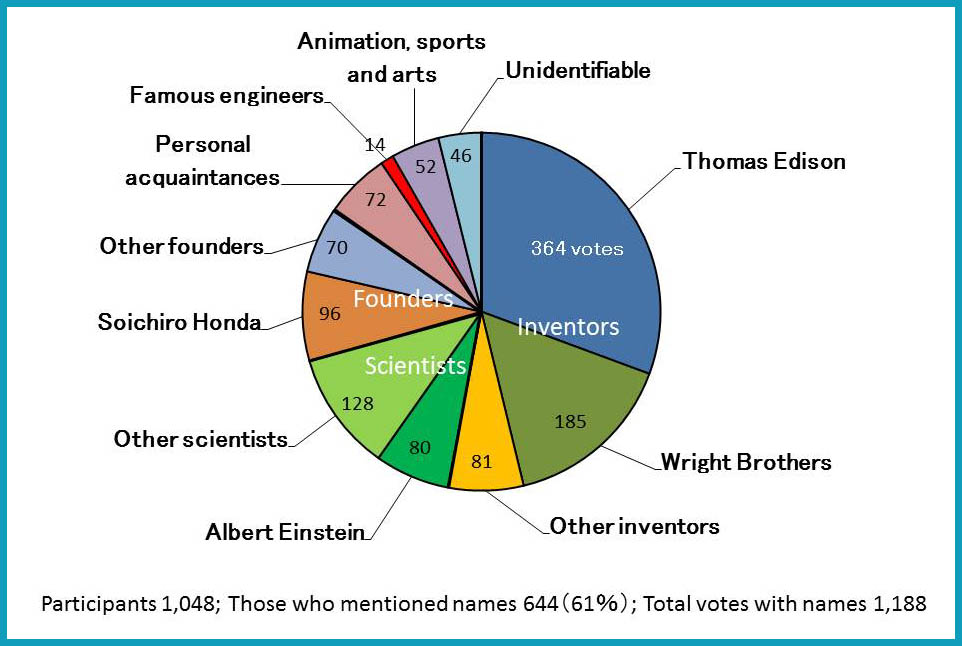
Applicants to universities must choose specific faculty and department of their interest. It means necessarily that they have to focus their future career to some extent. Since engineering related faculties and schools offer principally education for engineers, it is desirable that students start their study with sufficient understanding on the role and mission of engineers in society.
How do juveniles before university admission understand and image engineers? In order to find out the reality, I conducted a survey by questionnaire in 2007 with full support of Middle and High Schools attached to Kogakuin University. All pupils of two schools (12-17 years old) received a questionnaire that requested simply “Please mention names of three representative engineers you know.”
Total 1,048 pupils participated in this survey. After checking collected questionnaires, it came out that 644 pupils (61%) could mention at least one name of engineers (39% submitted blank sheets) and wrote total 1,188 names of a variety of persons (wrote 1.6 names on average). Then numbers of votes to each mentioned engineer were summed up for ranking. Since the difference of ranking between age groups seemed not essential, whole participated pupils were treated as a single group in the analysis.
The above pie graph indicates the distribution of votes to specific persons or groups. First, famous inventors like Thomas Edison, Wright Brothers, Graham Bell, Alfred Nobel, etc. collected 630 votes (53% of total). Edison and Wright Brothers showed a superb popularity. Then scientists like Albert Einstein, Isaac Newton, etc. followed with 208 votes (18%). Since no prior explanation on engineer and scientist was given to pupils, it’s natural that they hardly distinguished them. Next, famous founders of big enterprises like Soichiro Honda, Bill Gates, etc. collected 166 votes (14%). Further, personal acquaintances like teachers and relatives, famous engineers like astronauts and architects, and famous persons in animation, sports and arts field collected 72, 14, and 52 votes respectively. Votes with unidentifiable description reached 46.
The result of the above survey gave me a great shock! Answers were collected from pupils of schools that were attached to an engineering university. Even under this favorable situation juveniles had quite poor image on engineers. Persons in traditional engineering career collected only 1 % of total votes. If an engineering graduate gets a great success as an inventor, a scientist or an artist, it is quite a welcome surprise, but the success can’t be attributed to the direct outcomes of engineering education.
“People know well what engineers are performing in society.” That was merely an illusion. Juveniles participated in this survey revealed the reality. Who is responsible to this dilute presence of engineers in society? The answer is engineers themselves.
Engineer Series 2: Chorus of "We raise engineers!"

Japanese word "Gijutsu-sya" is usually translated to engineer but the meaning is not exactly the same. The following engineer is used in place of Gijyutsu-sya.
What are engineers to do? The majority may answer they are engaged in whatever engineering is concerned with. Such persons are called, to be exact, engineering practitioner (EP) in English. There are a variety of educational institutions aimed to raise EPs such as Technical High Schools (3 years), Vocational Schools (2 y.), Colleges of Technology (5 y.), Junior Colleges (2 y.), Universities (undergraduate 4 y.) and Graduate Schools (2+3 y.). The graduates of these schools must finish 3 to 12 (PhD) years study after 9 years duty education.
I surveyed how these educational institutions describe their mission. The representative and typical phrases that contain keyword “engineer” were picked up and summarized in the above picture. All institutions declare that they raise “engineers”, though a variety of adjectives and prepositions are added to.
People working in medical fields are called medical practitioner (MP). Doctors (MD) are the core of MPs and work together with licensed specialists such as nurses, therapists, clinical engineers, pharmacists and so on. As MDs are educated only in Medical Department of Medical Schools, other licensed specialists are educated in respective educational institutions.
Compared to the education system of medicine, that of engineering is quite primitive! “All educational institutions in medicine unanimously claim that they raise MPs.” Such incredible situation is still prevailing in engineering.
Is it not necessary to introduce a proper specialization in the education and training of engineering? Some may point out that there exists already a specialization such as civil, mechanical, electrical, etc. However, this corresponds to the classification of medical treatment such as internal, external and surgical, and is not a specialization due to the difference of core competence to be requested.
Compare the role of doctors and nurses. There is a distinct difference of core competence. This is the case also in engineering. There is an essential difference of core competence between a research/development engineer and a skilled technician!
In engineering, all relevant educational institutions declare we raise “engineers” that mean merely a group name and are indifferent from any qualification. Is this acceptable? The ideal is that everybody makes the most of own talent and carries the most adaptive work role with pride and responsibility. If we introduce specialization due to core competence like the case of medicine, it will inevitably happen that a kind of hierarchy is generated among EPs. “We love all are even!” This is surely a Japanese sentiment and is also welcome by Japanese enterprises that hire new graduates once a year with the same starting salary. It appears still no sign of change.
Engineer Series 3: From Nobel Prize to Gold Medal of World Skills Competition
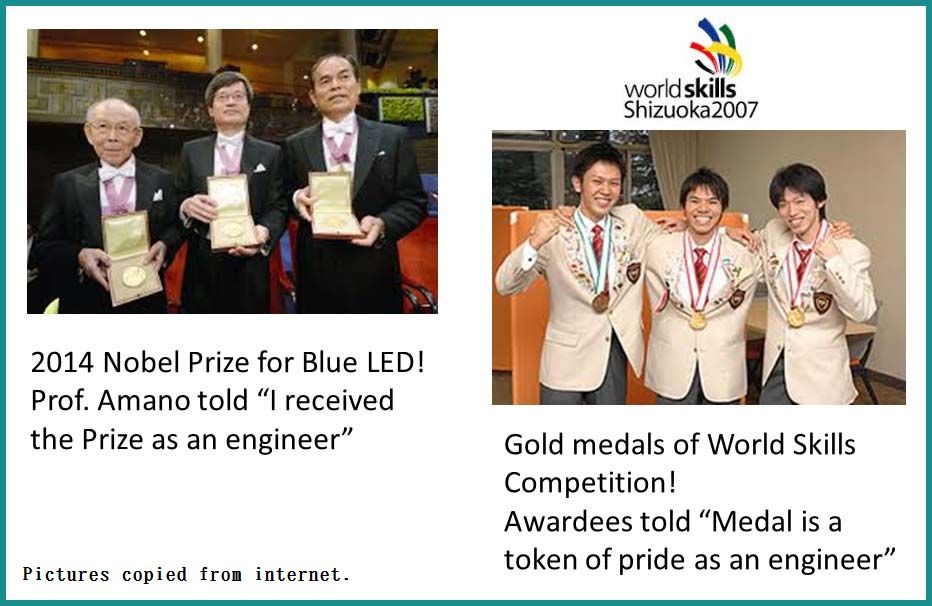
Japanese word corresponding to engineer is Gijyutsu-sya which means engineering practitioner performing every sort of tasks from research and development to manufacturing. The following engineer is used in place of Gijyutsu-sya. The reality that engineering schools of every stage declare “We raise engineers”, was the previous topics of this Series. This time, awarding, the proof of success, is selected to emphasize the diversity of engineers.
Nobel Prize is in all truth the highest honor of the world. Nobel Prize in physics, in chemistry and in physiology/medicine are thought to be given to scientific findings, but are given occasionally to technology development such as invention of new materials, etc. Alfred Nobel himself was a great inventor of dynamite that changed the world.
2014 Nobel Prize in physics was awarded to Drs. Akasaki, Amano and Nakamura for their invention and application of Blue LED as shown in the above picture. Not only Dr. Nakamura, originally a research engineer in a company, but also Prof. Amano, an academic in a university, told “I received the Prize as an engineer”.
There are a variety of engineering tasks. If we sort them according to the nature of required knowledge and skill, the task of research and development may locate on the leftmost end. Researchers working at this end have chance to get Nobel Prize. To perform this task, creativeness based on scientific knowledge, planning ability and endless pursuit mind are required. Nobody can foresee the result, success or retreat. Those who catch serendipity smile, while others continue struggling in a dark tunnel of search.
The task on the rightmost end may be manufacturing that needs various skills. The medalists of World Skills Competition shown above may stand at this end. World Skills Competition is held every two year at various cities of the world. Since the age of competitors is mostly limited under 22, this competition is called Skills Olympic for youth. Three awardees of Hitachi team, medalists of 2007 Competition in lathe, milling and drawing, told “Medal is a token of pride as an engineer”. To obtain skills of top levels, inherent physical aptitude, diligence to overcome long term training and concentration power are inevitable. We can’t compare the value of Nobel Prize and Gold Medal of Skills Competition, because the target of achievement is completely different. Both are common, however, in the fact that awardees are World Number 1.
Tasks for engineers distribute widely between the leftmost and rightmost ends shown above. The core competence required to perm each task is substantially different. In order to make the most of own ability, each engineer should choose a task that is most suitable to given character and talent. The most effective way to maintain industrial competitiveness in the headwind of decreasing population is to enhance the power and output of individuals. Engineering education must be, therefore, not uniform but correspondingly diverse.
Engineer Series 4: Professionals in three categories
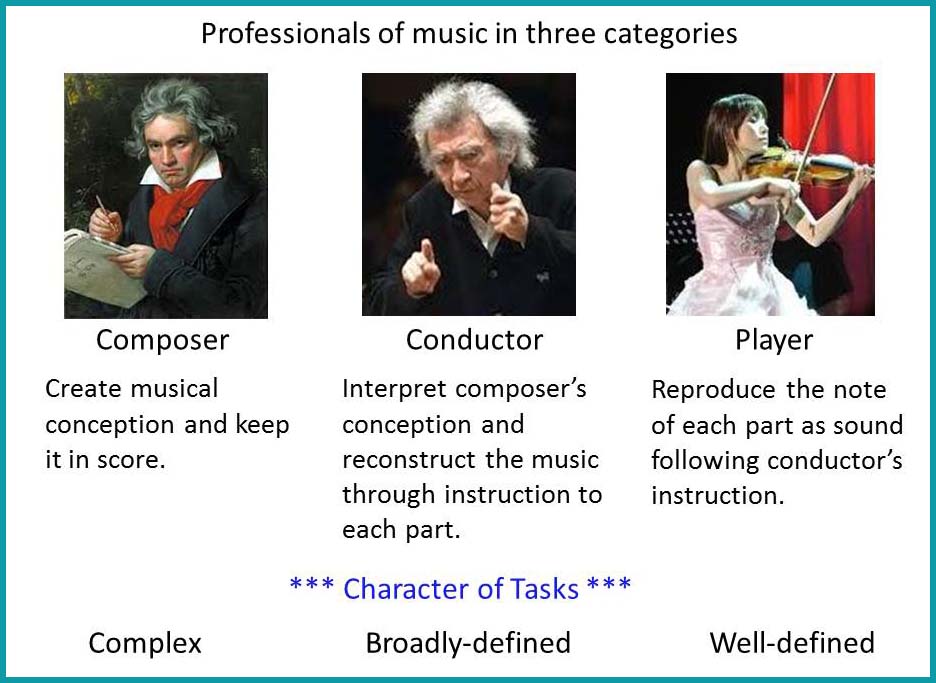
There are a variety of works that depend mostly on brain thinking, face to face communication, skilled handling, and so on. We live every day by combining such works unconsciously. Hereafter we think only work as an occupation, or preferably as a profession.
The field, in which professionals are well accepted and established, may be music. In order to enjoy the performance of an orchestra, three categories of professionals are indispensable, that is, composer, conductor and payer (performer). Their tasks are essentially different.
・ Composer: First create musical conception and keep it in a form of score that remain forever. Composition may take a moment or years to be completed. Musical conceptions are born from completely free imagination.
・Conductor: Interpret composer’s conception and faithfully reconstruct the music through instruction to each part. Communication and harmonization with members are essential.
・Player: Reproduce the music note of each part as sound following conductor’s instruction. Highest performance is always expected.
The character of tasks to be accomplished by these three categories is essentially different. Let’s characterize the task of composer, who is free from every constraint, as “Complex”, that of conductor, who is given a gross constraint such as score book, as “Broadly-defined”, and lastly that of player, who is given a precise constraint such as part note, as “Well-defined”.
When we classify the character of tasks into three categories as mentioned above, we find that this classification can apply to other fields in which professionals are distinctly visible. It could give impression that there exists a hierarchy like Complex>Broadly-defined>Well-defined, but it’s wrong. As there is no difference in value among composer, conductor and player, three categories are free from any hierarchy at all. Each role is indispensable and can’t be replaced by others.
Engineer Series 5: Various tasks in engineering
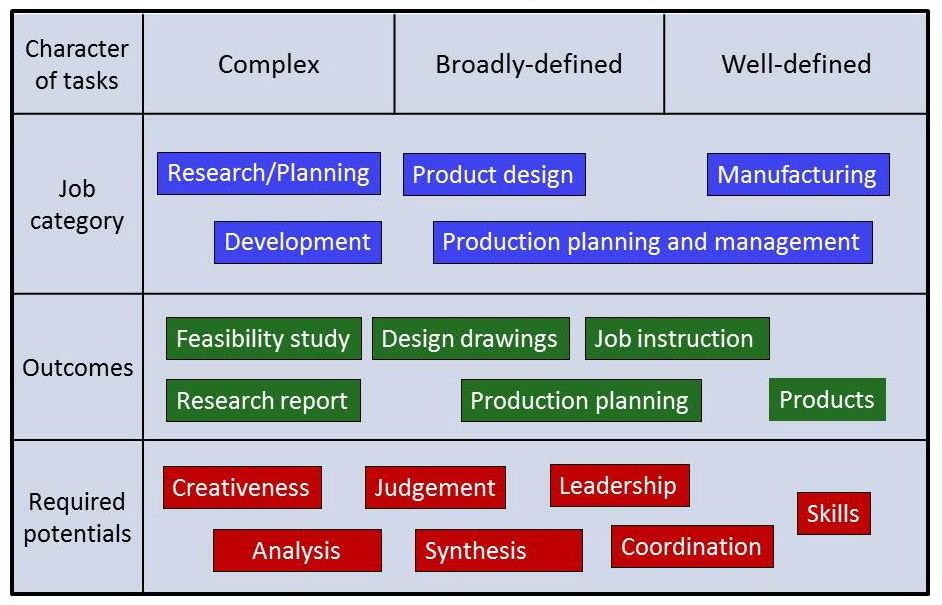
In the previous Series 4, tasks of professionals in music were classified into three categories, namely, Complex, Broadly-defined and Well-defined, represented by composer, conductor and player respectively. Tasks of professionals in engineering are far diverse than in music, but it may be possible to apply the same classification to engineering. To make the discussion simpler, the case of manufacturing industries producing hardware like automobile is selected.
Let’s think the categories of jobs necessary in such industries. The development of business depends on how new competitive products are innovated one after another. Research planning and Research itself are the most upstream job and its character is typically Complex. If once feasibility becomes positive, Development starts. After completing prototype development, Product design follows. Then Production planning and management establish procedures and sequences of every manufacturing process. Finally Manufacturing is carried in factories. The last Manufacturing is composed of jobs that are well-defined. All relevant jobs are arranged from upstream toward downstream as shown in the above picture and their character changes from Complex toward Well-defined.
The outcomes of necessary jobs are either in the form of documents, drawings or in products. They are Feasibility study, Research report, Design drawings, Production planning, Job instruction and finally Products. They can be also arranged like in the above figure according to their character.
The human potentials required to perform each job are also multilateral. Corresponding to the nature of jobs, the required potentials like Creativeness, Analysis, Synthesis, Judgement, Leadership, Coordination and Skills are assigned to the adequate location shown in the figure.
In the case of music it is quite simple because three categories correspond to three titles, i.e., composer, conductor and player. It is not so simple in engineering because there are so many job categories. If we call them all engineer, nothing will change from the present situation. We have to try to introduce new definition of titles corresponding to the three types of task characters. This effort is now ongoing under close cooperation with international engineering societies. The progress will be reported next time.
Engineer Series 6: Classification of Engineering Practitioners by IEA
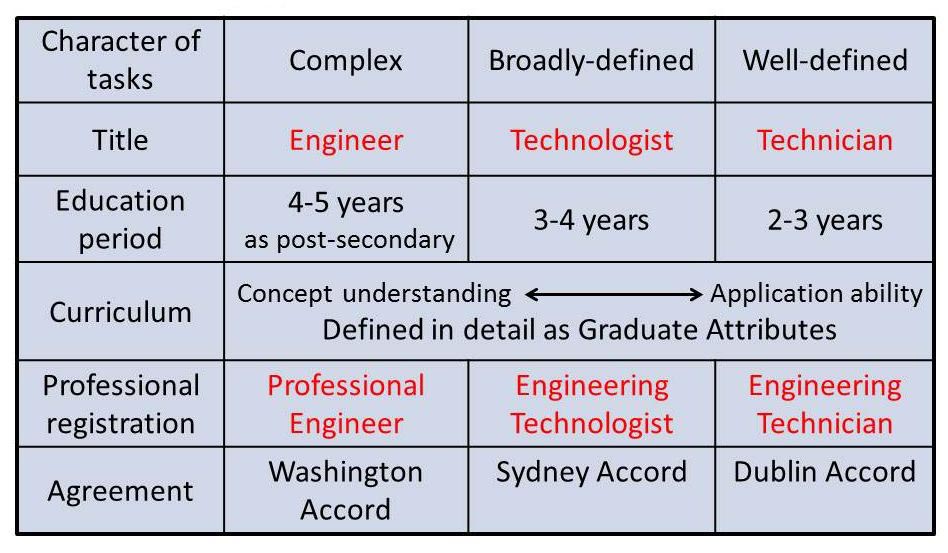
How to classify engineering practitioners according to their professional competency? The answer is the major interest of this Engineering Series. International Engineering Alliance (IEA) is the organization that is responsible to organize global rules in this respect. The Institute of Professional Engineers, Japan and Japan Accreditation Board for Engineering Education (JABEE) are representing Japanese interests in IEA.
As introduced in Series 4, professionals in music are classified to composer, conductor and player according to their character of tasks, i.e., Complex, Broadly-defined or Well-defined. This concept of classification was first adopted by IEA for classifying engineering practitioners. Engineering tasks are so divers and their character changes continuously as explained in the previous Series. IEA classifies titles and registers of engineering practitioners into three definite categories as indicated in the above picture.
According to the character of tasks there are three titles, Engineer, Technologist and Technician; and corresponding titles of professional register are Professional Engineer, Engineering Technologist and Engineering Technician.
In order to assure the quality of education and professional competency of each category, period of post-secondary education, curriculum (defined as Graduate Attributes) , requirement for professional register (defined as Professional Competency Profiles), basis of international agreement are precisely documented by IEA.
IEA has succeeded to introduce rules and procedures to define titles and professional registers in engineering, however, the goal is still far away until the system is globally accepted and acknowledged. Followings are obstacles that we have to break through;
1. Engineer is different from engineering practitioner general. Changing social common sense is so difficult!
2. Technologist is socially almost unknown. Its character is somewhat halfway and lacks attraction.
3. The definition and concept cannot dispel the impression of upper, middle and lower class. The appeal that each category has irreplaceable value and mission is insufficient.
Japanese engineering system must be fundamentally consistent with global rules set by IEA, but should have distinctive features that match our culture and mentality. My lifetime dream is to introduce Japan-specific classification in which every engineering practitioner makes the most of own inherent talent and works with confidence and pride!
Engineer Series 7: Science, technology and related professionals

As introduced in the previous Series, International Engineering Alliance
(IEA) classified engineering practitioners to three titles, i.e., Engineer,
Technologist and Technician. Among them “Technologist” is especially unfamiliar
and seems uneasy to be acknowledged widely in society. On this occasion
I would like to summarize the wording used in the discussion over science
and technology. As indicated in the above picture, there are two independent
regions, Science and Technology. Science is knowledge, while Technology
is profession.
Science in this case means natural science that was born in 16th Century and is based exactly on verifiable facts. Its history is rather new. On the other hand, Technology has been created, accumulated and handed down over generations together with the development of human civilization. Pyramid and Great Wall are the symbols of ancient technology. Since modern science was born, Technology has been accelerating by absorbing new findings of scientific development. Science-based technology is nowadays the essential part of Technology and is called Engineering. The rest of Technology consists of traditional technology (handed down orally or by secret document on a specific profession) or indigenous technology (told down by local events). There is no definite word to express technology except engineering, so we use Traditional Technology as in the abovepicture.
Now, let’s list up the titles of specialists who work for Science and Technology. Those who work for Science are called Scientist, quite simple and direct. In the same way, are those who work for Technology called Technologist? This naming may be theoretically wright, but is not used commonly since it includes too diverse roles. Engineering is carried by Engineering Practitioners who are classified further to Engineer, Technologist and Technician by IEA. There are a variety of titles of those who work for Traditional Technology; Master, Craftsman, etc.
Technologist indicated by red in the above picture, is the most ambiguous naming. IEA must have had a lot of discussion to decide the title between Engineer and Technician. Associate Engineer or Incorporated Engineer was the candidate in the initial stage but not adopted, since it implies a nuance of "subordinated" like Associate Professor. Technologist was the final candidate.
In the discussion of an international agreement, English-speaking stakeholders are most influential and seize the initiative to settle documents in English. Non-English-speaking stakeholders must follow the decision. How we translate Engineer, Technologist and Technician into Japanese; we have to start the discussion.
Engineer Series 8: Proposal for the classification of engineers

How to classify engineering practitioners, and how to enhance their professional development. These problems are the central themes of the present Engineer Series. Proper choice of rules and procedures will enhance the pride and responsibility of engineers, improve social understanding, and finally help young generation decide their career path.
As explained in the present Series 6, International Engineering Alliance (IEA) decided to classify engineering practitioners to three categories, that is, Engineer, Technologist and Technician. I see some vulnerable points of this classification such that Technologist is too much intermediate and lacks independent character, and also that there remains still the impression of grading from upper to lower class.
Following is my personal proposal for the classification of engineers that matches specifically Japanese circumstances, while basic accordance with IEA rules is maintained.
Tasks of engineers are so diverse that we better think objectively by imaging industries that manufacture products. Now we divide them to three groups as shown in the above figure. The first group carries research and development that incubate a new idea and develop the idea up to production-ready prototype. Following group is responsible to design, build and operate manufacturing system that assures desired quality and costs. The last group bears manufacturing itself applying human skills of various kinds. Character of the tasks of the three groups varies from complex to broadly- and to well-defined similar to the concept of IEA. Now we give the engineers of each group the title of R&D Engineer, Engineer and Technician, respectively. Professional registration and corresponding Accord for mutual recognition are listed also in the above figure.
The above proposal has two distinct features compared to the IEA rules. First, Technologist disappeared from the list, since its character is too intermediate and lacks appeal to be involved. Nowadays, majority of engineering graduates from major universities proceed to Master programs, and partly further to Doctorate. Second feature is to introduce a new group titled R&D Engineer. The importance of R&D in engineering has been growing and will grow further in the future. By introducing new category, R&D Engineer, education and training in this field will be significantly enforced. R&D Engineer in this proposal is included in the category of Engineer by IEA rules.
The above proposal seems still too rough and needs further refinement. Since there are few persons interested in the classification of engineers, I wish to ignite fire to collect attention by this proposal.
Engineer Series 9: Revised proposal for the classification of engineers

How to classify engineering practitioners, and how to enhance their professional development. These problems are the central issues of the present Engineer Series. In the previous Series 8, I explained my opinion and introduced a private proposal. This proposal contains, however, a week point that both Engineering Practitioners and Engineers are expressed by the same Japanese word "技術者Gijutsusya".
The revised proposal shown in the above picture looks almost the same as the previous one as far as English expression is concerned. The essential difference is that Engineering Practitioners are no more called "Gijutsusya" but "技術従事者Gijutsujujisya" in Japanese.
I sustain from adding further words since this discussion is only meaningful among Japanese-speaking people.
Engineer Series 10: Summary and remarks
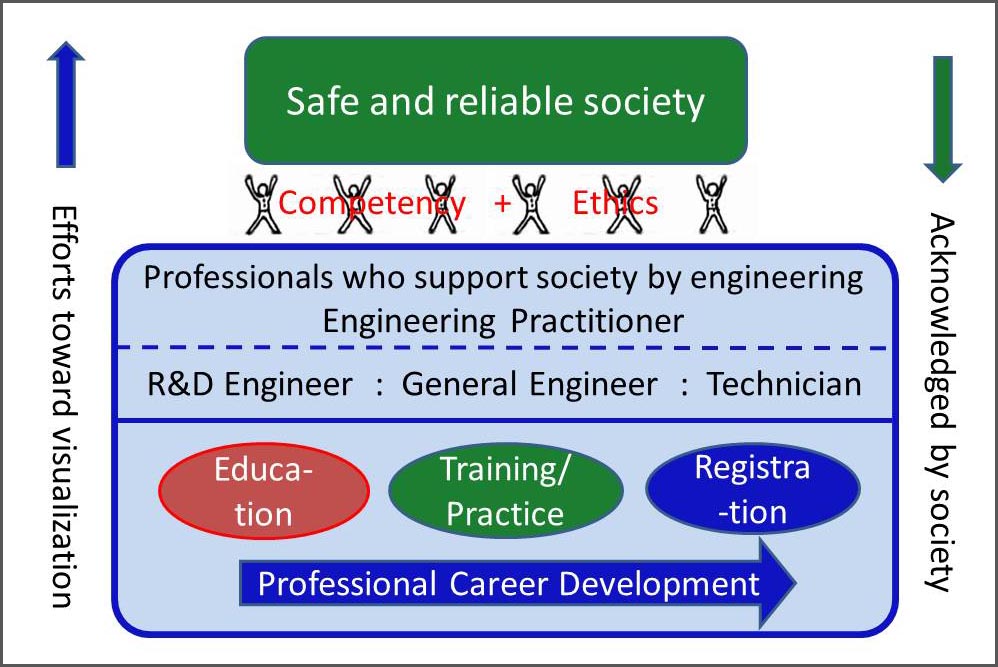
In order to sustain a safe and reliable society we desire, specialists
with high competence and ethical motivation are expected to perform their
duty in a specific field of social needs. Such specialists are called “professionals”.
Professionals who offer service relating to human health, are medical
practitioners, that is, MDs, nurses, pharmacists, etc. Modern society is
filled with a variety of human-made products, i.e. artifacts. Health of
artifacts is a great concern in civilized society. The service to create,
manufacture, operate and maintain artifacts is called engineering. Professionals
in engineering are engineering practitioners. They are, of course, important
supporters of safe and reliable society as shown in the above picture.
Tasks in engineering are quite diverse, ranging from research and development
to skill-based manufacturing. The core competence needed to carry each
task could be substantially different. Over the classification of engineering
practitioners their remain still disputes domestically as well as internationally
as repeatedly mentioned in the present Series. My proposal to introduce
three engineering titles, that is, R&D Engineer, General Engineer and
Technician, is shown in the above picture as an example.
The professional career development of engineering practitioners may not be uniform, but should be organized independently to each engineering title. Each engineering practitioner choses a title most suitable to one’s talent and interest, and continue professional development, starting from education to training/practice and registration, for life-time. Japan is facing the decrease of population. The above scheme of the professional development may be the most effective way to maintain national power by making the most of individual’s potential.
If we ask young generation “What are engineers doing?”, the answer will
be “???”. If engineering practitioners want to make sure that they are
professionals needed to sustain safe and reliable society, they should
visualize themselves and show what they are doing. Classification of engineering
practitioners is an essential element of such visualization and easy understanding.
Visualization is also the most effective means to attract young generation
to the way of engineering.
Present Engineers Series 1 to 10 tried to show the overall picture of engineering and its practitioners. I hope this Series help visualize the problems engineers are facing.
---End of Series---